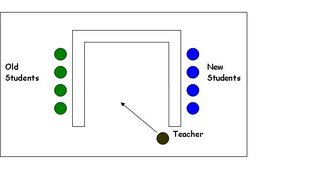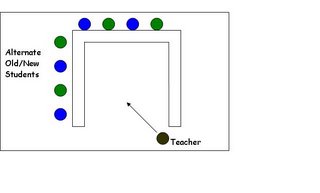I was once Director of Studies for a large language school, and one of the parts of the job that I liked least was that if students complained about anything, it was up to me to sort it out. One day in October, a few weeks after courses had started, four students came to me. They were new to the school, and they complained that their teacher continually ignored them, talking and asking questions only to the other four students who had been in the class the previous year. I promised them I would talk to the teacher and get back to them.
When I spoke to the teacher she was clearly genuinely shocked at the complaint, said that she didn’t ignore anyone and, far from asking questions only to the old students, didn’t nominate anyone and waited to see who would respond. I said I’d come and watch a lesson to see if we could sort the problem out.
 When I got to the lesson I found the classroom layout shown in the first diagram. The 12 desks were in a horseshoe shape, and the students had seated themselves with the four “old” students on the left and the four new students on the right. This meant that they were in a psychologically “antagonistic” position – 2 well-defined groups facing each other with a physical barrier - the desks and the space – in between.
When I got to the lesson I found the classroom layout shown in the first diagram. The 12 desks were in a horseshoe shape, and the students had seated themselves with the four “old” students on the left and the four new students on the right. This meant that they were in a psychologically “antagonistic” position – 2 well-defined groups facing each other with a physical barrier - the desks and the space – in between.
The teacher stood, for nearly 100% of the time, on the right in front of the new students. But her body and her gaze pointed left. This meant that she had eye-contact only with the old students and seemed to be directing her questions, instructions and explanations only at them.
When I talked to the teacher after the lesson, I found that she was totally unaware of what was happening. Not only had she not thought about the effect that the seating arrangement was having but she had not realised that she stood in one particular place. I suggested that she tried consciously standing in other positions in her other lessons, and she came back later to say that yes – the other positions seemed strange and unusual. We decided that for full classes she’d make sure she stood centrally and looked at each part of the class in turn, but for smaller classes the arrangement in the second diagram would work better. She remained standing where she was comfortable, but sat the students around the arm and the back of the horseshoe, alternating old student /new student.
I asked the students to come back after a few more weeks and to tell me how they now felt. They said the problem had been completely resolved. They now not only felt they got equal attention from the teacher, but also felt part of the group. They no longer always sat alternately, but it no longer mattered – the group was working as one, not two.
Two things interested me about this situation. Firstly, the fact that the teacher hadn’t thought through the effect that the seating pattern was having, psychologically, on the students. Since then I’ve frequently seen the same thing happening in other classes, and I’ll discuss it in more detail in another post. But the second thing was that our perceptions of what we are doing and what is happening are often not an accurate reflection of what the students are experiencing. None of us ever see ourselves exactly as others see us – which is why watching yourself on video is often such a shock. But as teachers we need to be aware of our blind spots and the effect they are having.
Videoing your lessons is one way – but keep in mind that, as I said before, everyone is always horrified by what they see. Use the video constructively – identify a few specific things which you do which you feel are counter productive and then take one at a time and work on it. Don’t try and change everything at once.
If you can’t (or don’t want to) arrange for you lesson to be videoed, then ask someone else, preferably an experienced teacher but definitely someone you trust, to come in and watch a lesson or part of a lesson. Ask them to note down anything which you do which they would do differently, then afterwards discuss with them the pros and cons of the two approaches. Alternatively, ask a confident teacher if you can observe their lessons, and notice for yourself what’s different. Often it’s only be seeing someone do things differently that you even realise that you always do something in one particular way. You may find it useful to limit the observation to a specific area -Giving instructions and setting up activities, Using the board, Explaining grammar etc. In any case, after the lesson discuss or think about the pros and cons of the different approaches. And maybe try out the other teacher’s approach to see how it feels and how your students react. Ask them which they prefer – and once they see that you’re open to new ideas and willing to try things out, ask them if there’s anything else that they’ve noticed that they feel is counter-productive to the lesson. Your students’ ideas are another valuable form of feedback – but that too is a topic for another post.
Recommended Reading
Hadfield, J. Classroom Dynamics, Oxford
Keep in mind that Amazon often have both new and used copies of the books you want at prices much lower than those shown. so it's always worth clicking to find out - and no, we don't earn anything from your clicks.
When I spoke to the teacher she was clearly genuinely shocked at the complaint, said that she didn’t ignore anyone and, far from asking questions only to the old students, didn’t nominate anyone and waited to see who would respond. I said I’d come and watch a lesson to see if we could sort the problem out.
 When I got to the lesson I found the classroom layout shown in the first diagram. The 12 desks were in a horseshoe shape, and the students had seated themselves with the four “old” students on the left and the four new students on the right. This meant that they were in a psychologically “antagonistic” position – 2 well-defined groups facing each other with a physical barrier - the desks and the space – in between.
When I got to the lesson I found the classroom layout shown in the first diagram. The 12 desks were in a horseshoe shape, and the students had seated themselves with the four “old” students on the left and the four new students on the right. This meant that they were in a psychologically “antagonistic” position – 2 well-defined groups facing each other with a physical barrier - the desks and the space – in between.The teacher stood, for nearly 100% of the time, on the right in front of the new students. But her body and her gaze pointed left. This meant that she had eye-contact only with the old students and seemed to be directing her questions, instructions and explanations only at them.
When I talked to the teacher after the lesson, I found that she was totally unaware of what was happening. Not only had she not thought about the effect that the seating arrangement was having but she had not realised that she stood in one particular place. I suggested that she tried consciously standing in other positions in her other lessons, and she came back later to say that yes – the other positions seemed strange and unusual. We decided that for full classes she’d make sure she stood centrally and looked at each part of the class in turn, but for smaller classes the arrangement in the second diagram would work better. She remained standing where she was comfortable, but sat the students around the arm and the back of the horseshoe, alternating old student /new student.

I asked the students to come back after a few more weeks and to tell me how they now felt. They said the problem had been completely resolved. They now not only felt they got equal attention from the teacher, but also felt part of the group. They no longer always sat alternately, but it no longer mattered – the group was working as one, not two.
Two things interested me about this situation. Firstly, the fact that the teacher hadn’t thought through the effect that the seating pattern was having, psychologically, on the students. Since then I’ve frequently seen the same thing happening in other classes, and I’ll discuss it in more detail in another post. But the second thing was that our perceptions of what we are doing and what is happening are often not an accurate reflection of what the students are experiencing. None of us ever see ourselves exactly as others see us – which is why watching yourself on video is often such a shock. But as teachers we need to be aware of our blind spots and the effect they are having.
Videoing your lessons is one way – but keep in mind that, as I said before, everyone is always horrified by what they see. Use the video constructively – identify a few specific things which you do which you feel are counter productive and then take one at a time and work on it. Don’t try and change everything at once.
If you can’t (or don’t want to) arrange for you lesson to be videoed, then ask someone else, preferably an experienced teacher but definitely someone you trust, to come in and watch a lesson or part of a lesson. Ask them to note down anything which you do which they would do differently, then afterwards discuss with them the pros and cons of the two approaches. Alternatively, ask a confident teacher if you can observe their lessons, and notice for yourself what’s different. Often it’s only be seeing someone do things differently that you even realise that you always do something in one particular way. You may find it useful to limit the observation to a specific area -Giving instructions and setting up activities, Using the board, Explaining grammar etc. In any case, after the lesson discuss or think about the pros and cons of the different approaches. And maybe try out the other teacher’s approach to see how it feels and how your students react. Ask them which they prefer – and once they see that you’re open to new ideas and willing to try things out, ask them if there’s anything else that they’ve noticed that they feel is counter-productive to the lesson. Your students’ ideas are another valuable form of feedback – but that too is a topic for another post.
Recommended Reading
Hadfield, J. Classroom Dynamics, Oxford
Keep in mind that Amazon often have both new and used copies of the books you want at prices much lower than those shown. so it's always worth clicking to find out - and no, we don't earn anything from your clicks.
No comments:
Post a Comment